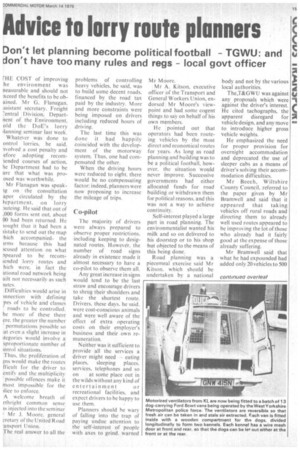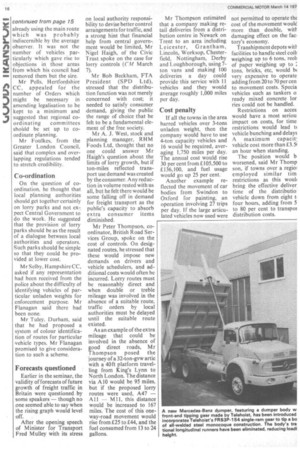Advice to lorry route planners
Page 17

Page 18

If you've noticed an error in this article please click here to report it so we can fix it.
Don't let planning become political football TGWU: and don't have too many rules and regs local govt officer
r HE COST of improving he environment was neasurable and should not txceed the benefits to be ohained. Mr G. Flanagan. ssistant secretary. Freight 7entral Division, Departnent of the Environment, old the DoE's lorry Planning seminar last week. Whatever was done to ontrol lorries, he said. lvolved a cost penalty and ,efore adopting recom'tended •courses of action, he Department had to be ure that what was proosed was worthwhile.
Mr Flanagan was speakon the consultation aper circulated by the )epartnnent, on lorry Juteing. He said that out of .000 forms sent out, about 00 had been returned. He tought that it had been a iistake to send out the map
• hich accompanied, the )rms because this had )cused attention on what tmeared to be recomtended lorry routes and hich were, in fact the ational road network being uilt not necessarily as such mites.
Difficulties would arise in mnection with . defining • pes of vehicle and classes ' roads to be controlled. he more of these there ere, the greater the number permutations possible so at even a slight increase in itegories would involve a sproportionate number of )ntrol situations.
Thus, the proliferation of zns would make the routes -fficult for the driver to entify and the multiplicity possible offences make it most, impossible for the )lice to enforce.
A welcome breath of rthright common sense. is injected into the seminar
• Mr .1. Moore. general eretary of the United Road • ansport Union.
The real answer to all the problems of controlling heavy vehicles, he said, was to build some decent roads, financed by the road tax paid by the industry. More and more constraints were being imposed on drivers including reduced hours of The last time this was done it had happily coincided with the development of the motorway system. Thus, one had compensated the other.
When the driving hours were reduced to eight, there mould be no compensating factor: indeed, planners were now proposing to increase the mileage of trips.
Co-pilot
The majority of drivers were always prepared to observe proper restrictions, including keeping to designated routes. However. the number of road signs already in existence made it almost necessary to have a co-pilot to observe them all.
Any great increase in signs would tend to be the last straw and encourage drivers to shrug their shoulders and take the shortest route. Drivers, these days. he said, were cost-conscious animals and were well aware of the effect of extra operating costs on their employer's business and their own remuneration.
Neither was it sufficient to provide all the services a driver might need eating places, sleeping places, services, telephones and so on at some place out in the wilds without any kind of' entertainment or recreational facilities, and expect drivers to he happy to use them.
Planners should he wary of falling into the trap of paying undue attention to the self-interest of people with axes to grind, warned Mr Moore.
Mr A. Kitson, executive officer of the Transport and General Workers Union, endorsed Mr Moore's viewpoint and had some cogent things to saY on behalf of his own members.
He pointed out that operators had been routeing vehicles by the most direct and economical routes for years. As long as road planning and building was to be a political football, however, the situation would never improve. Successive governments had either allocated funds for road building or Withdrawn them for political reasons, and this was not a way to achieve continuity.
Self-interest played a large part in road planning. The environmentalist wanted his milk and so on delivered to his doorstep or to his shop but objected to the means of this being done.
Road planning was a piecemeal exercise said Mr Kitson, which should be undertaken by a national body and not by the various local authorities.
The..T&GWU was against any proposals which were against the driver's interest. He cited tachographs, the apparent disregard for vehicle design, and any move to introduce higher gross Vehicle weights.
He emphasized the need for proper provision for overnight accommodation and deprecated the use of sleeper cabs as a means of driver's solving their accommodation difficulties.
Mr Beech, Wiltshire County Council, referred to the paper given by Mr Bramwell and said that it appeared that taking vehicles off rural roads and directing them to already well used routes appeared to be improving the lot of those who already had it fairly good at the expense of those already suffering.
Mr Bramwell said that what he had expounded had added only 20 vehicles to 500 continue° from page 15 already using the main route which was probably indiscernible by the average observer. It was not the number of vehicles particularly which gave rise to objections in those areas from which his council had removed them but the size.
Mr Pelts, Hertfordshire CC, appealed for the number of Orders which might be necessary in amending legalisation to be kept to a minimum and suggested that regional co ordinating committees shoUld be set up to coordinate planning.
Mr Foulkes, from the Greater London Council, said that complex and overlapping regulations tended to stretch credibility.
Co-ordination
On the question of coordination, he thought that local planning authorities should get together certainly on lorry parks and not expect Central Government to do the work. He suggested that the provision of lorry parks should be as the result of a dialogue between local authorities and operators. Such parks should be simple so that they could be provided at lower cost.
Mr Selby, Hampshire CC, asked if any representation had been received from the police about the difficulty of identifying vehicles of particular unladen weights for enforcement purpose. Mr Flanagan said there had been none.
Mr Tuley, Durham, said that he had proposed a system of colour identification of routes for particular vehicle types. Mr Flanagan promised to give consideration to such a scheme.
Forecasts questioned
Earlier in the seminar, the validity of forecasts of future growth of freight traffic in Britain were questioned by some speakers — though no one seemed able to say when the rising graph would level off.
After the opening speech of Minister for Transport Fred Mulley with its stress
on local authority responsibility to devise better control arrangements for traffic, and a strong hint that financial help from central government would be limited, Mr Nigel Haigh, of the Civic Trust spoke on the case for lorry controls (CM March 7).
Mr Bob Beckham, FTA President (SPD Ltd), stressed that the distribution function was not merely concerned with cost; it needed to satisfy consumer demand, giving the public the range of choice that he felt to be a fundamental element of the free society.
• Mr A. J. West, stock and planning manager, RH M Foods Ltd, thought that no one could answer Mr Haigh's question about the limits of lorry growth, but if ton-miles reflected transport use demand was created by the consumer. Any reduction in volume rested with us all, but he felt there would be some falling off in demand for freight transport as the public's capacity to absorb extra consumer items diminished.
Mr Peter Thompson, coordinator, British Road Services Group, spoke on the cost of controls. On designated routes, he stressed that these would impose new demands on drivers and vehicle schedulers, and additional costs would often be incurred. Lorry routes must be reasonably direct and when double or treble mileage was involved in the absence of a suitable route, traffic orders by local authorities must be delayed until the suitable route existed.
As an example of the extra mileage that could be involved in the absence of good direct roads, Mr Thompson posed the journey of a 32-ton-gvw artic with a 40ft platform travelling from King's Lynn to North London. The distance via A10 would be 95 miles, but if the proposed lorry routes were used, A47 — All M 11, this distance would be increased to 167 miles. The cost of this oneway-road movement would rise from £25 to £44, and the fuel consumed from 13 to 24 gallons. Mr Thompson estimated that a company making retail deliveries from a distribution centre in Newark on Trent to an area including Leicester, Grantham, Lincoln, Worksop, Chesterfield, Nottingham, Derby and Loughborough, using 7ton vans and making 100 deliveries a day could provide this service with 11 vehicles and they would average roughly 1,000 miles per day.
Cost penalty
If all the towns in the area barred vehicles over 3-tons unladen weight, then the company would have to use 4-ton capacity vehicles and 16 would be required, averaging 1,750 miles per day. The annual cost would rise 30 per cent from £105,500 to £136,100, and fuel usage would go up 25 per cent.
Another example reflected the movement of car bodies from Swindon to Oxford for painting, an operation involving 27 trips per day. If the large articulated vehicles now used were not permitted to operate thc cost of the movement would more than double, witt damaging effect on the factory's economy.
Transhipment depots witt facilities to handle steel coil: weighing up to 6 tons, reeli of paper weighing up to tons, bricks, etc, would IN very expensive to operate adding from 20 to 70 per cen to movement costs. Specia vehicles such as tankers o ready mixed concrete lor ries could not be handled.
Restrictions on acces would have a most seriou impact on costs, for time restrictions would lead tc vehicle bunching and delays A maximum capacit: vehicle cost more than .E3.51 an hour when standing.
The position would b worsened, said Mr Thomp son, if towns over a regioi employed similar tim restrictions as this wouli bring the effective deliver time of the distributio vehicle down from eight four hours, adding from 5 to 80 per cent to transpot distribution costs.








































































































